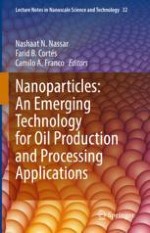This book assesses the current development and potential applications of nanoparticle technology in oil industry and explores new research directions in this frontier field. It outlines the theory and practical challenges of the nanoparticle colloidal behavior in oil matrixes and aqueous solutions, the interactions between rock and nanofluid, nanoparticles and asphaltenes, and the surface phenomena relevant to the application of this technology. The book also describes the transport behavior of nanoparticles in oil/sand media for in-situ upgrading and recovery of heavy oil. Currently, the main objectives of applying nanoscale materials in oil industry are the remediation of formation damage, the improvement of energy efficiency, the abatement of environmental footprints and the increment of recovery factors of oil reservoirs, to name a few. The book consists of 15 chapters with contributions by leading experts in the topics of fabrication methods, opportunities and challenges in the oil & gas industry, modeling and application of nanofluids in the field and environmental applications of nanoparticles. The growing demand for oil has led to the need to exploit unconventional oil resources, such as heavy and extra-heavy crude oil. However, in the current context, upgrading and recovery of heavy oil are highly energy and water intensive, which consequently results in environmental impacts. Therefore, it is necessary to search for new ideas and alternatives in the field of in-situ and ex-situ upgrading and recovery to improve current technologies and make them both environmentally sound and cost-effective. Research conducted by the authors and numerous other researchers has shown that nanoparticle technology could be successfully employed for enhancing the upgrading and recovery of heavy oil with cost-effective and environmentally friendly approaches. Examples on the applications of nanoparticles in heavy oil include the adsorption, oxidation, and gasification/cracking of asphaltenes, a problematic constituent present in heavy oils; in-situ upgrading of the Athabasca bitumen by multi-metallic in-situ prepared nanocatalysts; the inhibition of precipitation and deposition of asphaltnes; and the enhanced perdurability against asphaltene damage in oil sands porous media by injection of nanofluids; sequestration of oil from spilled by nanoparticles, cleaning up oil sand process affected water by integrating nanoparticle with conventional treatment processes, etc.
